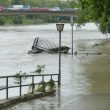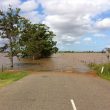Under water? This guide can help cities and towns navigate the flood
Last month, remnants of Hurricane Ida churned through the eastern U.S., leaving a trail of devastation in its wake. The rain fell fast and hard, breaking records set just 11 days earlier by Tropical Storm Henri. Ultimately, the storm killed 82 people, as waterfalls roared into subway stations and storm stations were overwhelmed, turning roadways into rivers.
Hurricane Ida was a tragedy—and a preview of a wetter, more dangerous future.
According to the latest report by the Intergovernmental Panel on Climate Change, we can expect more intense rainfall and flooding as the planet warms. We are not ready: the American Society of Civil Engineers gives our nation’s storm water infrastructure a “D” grade, as legacy systems struggle to cope with urban growth and heavier rains.
These challenges are daunting even for large, well-resourced cities. For smaller cities and towns—especially in historically marginalized communities—they can seem insurmountable. But a new guide, Navigate the Flood, can help.
Created by the Water Center at the University of Pennsylvania and the WaterNow Alliance, Navigate the Flood offers a curated set of resources for city and utility staff dealing with flood and storm water challenges. For those who don’t know where to start, the guide walks users through five process-oriented steps, each with easy-to-understand explanations. And the guide’s searchable library includes 97 technical and financial resources—including a list of national, state and regional technical assistance providers.
Navigate the Flood contains plenty of inspiration for decision makers faced with intractable challenges. For example, it offers the case study of Camden, N.J., the poorest city in that state. Camden is one of some 860 municipalities across the U.S. with an outdated “combined sewer system,” in which storm water is funneled into the same pipes that handle raw sewage. On a good day, all that wastewater goes to a sewage treatment plant. But on a bad day—and climate change guarantees more of those—heavy precipitation exceeds the capacity of the pipes and untreated sewage is dumped directly into local rivers.
To address the problem, Camden’s Municipal Utility Authority worked with the EPA and representatives from the community-based Camden SMART Initiative. They came up with a plan to deploy “green infrastructure”—riverfront parks and rain gardens that absorb storm water while providing amenities for residents. The project also created jobs in the community by hiring at-risk youth to maintain the new green infrastructure. This successful project has been emulated by other towns in the region.
In Camden and elsewhere, efforts to reduce flooding work best when community members play an active role. Effective community engagement builds public understanding and support, while harnessing local knowledge and expertise. It is especially important to bring in representatives of marginalized groups, who are most likely to live in areas at risk of flooding. For these reasons, Navigate the Flood offers a Stakeholder Engagement Plan, which details strategies to involve community members at every step.
The Navigate the Flood guide received funding support from The Kresge Foundation’s Environment Program through its Climate Resilient and Equitable Water Systems (CREWS) initiative. CREWS was launched in 2016 to transform urban storm water and wastewater systems to provide reliable, equitable and innovative services to all community residents. The CREWS initiative supports more than 30 organizations working to advance solutions to climate-related storm and flood impacts, with a focus on low-income communities and communities of color.
Hurricane Ida was not an outlier. As the planet heats up, all our cities—large and small, rich and poor—must prepare for a wetter future. While there is no one-size-fits-all solution, Navigate the Flood offers a wealth of resources to help local decisionmakers create a plan that works.
Laurie Mazur is the editor of the Island Press Urban Resilience Project, which is supported by The Kresge Foundation and The JPB Foundation. Her writing has appeared in Quartz and The Hill.




















